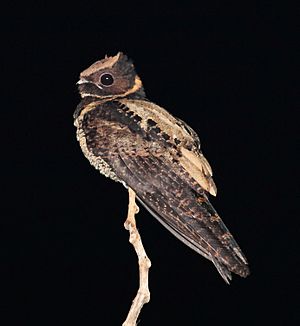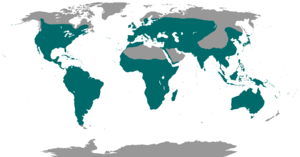Nightjar facts for kids
Quick facts for kids Nightjar |
|
|---|---|
 |
|
| Great eared nightjar | |
| Scientific classification |
|
| Kingdom: | Animalia |
| Phylum: | Chordata |
| Class: | Aves |
| Order: | Caprimulgiformes |
| Family: | Caprimulgidae Vigors, 1825 |
| Subfamilies | |
|
|
 |
|
| Global range of nightjars and allies | |
Nightjars are medium-sized nocturnal (active at night) or crepuscular (active at dawn and dusk) birds. They belong to the family Caprimulgidae. These birds have long wings, short legs, and very short beaks.
They are sometimes called goatsuckers because of an old folk tale. People used to believe these birds sucked milk from goats! The Latin name for goatsucker is Caprimulgus. They are also known as bugeaters because they mostly eat insects. Some species in the New World (North and South America) are called nighthawks. The name "nightjar" first referred to the European nightjar.
Nightjars live all over the world, except in Antarctica and some island groups like Madagascar. They can be found in many different places, especially open areas with some plants. They usually build their nests on the ground. They also often rest and sleep on roads.
Contents
Types of Nightjars
Scientists group nightjars into three main subfamilies. These groups are the typical nightjars (Caprimulginae), the nighthawks (Chordeilinae), and the eared nightjars (Eurostopodinae).
All nightjars have small feet that aren't very good for walking. They also have long, pointed wings. Typical nightjars have special bristles around their mouths and longer beaks. Their soft feathers are colored to help them blend in with tree bark or leaves. This helps them hide during the day. Some species even perch along a branch instead of across it, which makes them even harder to spot!
The common poorwill is a special kind of nightjar. It can go into a deep sleep, almost like hibernation, for weeks or months. Its body temperature drops a lot during this time. Other nightjars can also go into a similar state for shorter periods.
Scientists study the DNA of birds to understand how different groups are related. This helps them classify birds into families and subfamilies.
Where Nightjars Live and What They Like
Nightjars live on all continents except Antarctica. They also live on some island groups like Madagascar and the Seychelles. They don't usually live in very dry desert areas.
These birds can live at many different heights, from sea level up to about 4,200 meters (13,780 feet). Many species are experts at living in mountains. Nightjars live in a wide range of places, from deserts to rainforests. But they are most often found in open areas with some plants.
Nighthawks only live in the New World (North and South America). Eared nightjars are found in Asia and Australia.
Many nightjar species migrate, meaning they travel long distances. However, because they are secretive birds, we don't fully understand all their travel habits. Species that live in very cold northern areas, like the European nightjar, fly south when winter comes. For example, European nightjars from southern England spend their winters in the southern part of the Democratic Republic of the Congo. Other species make shorter trips.
Conservation and Status
Some types of nightjars are in danger of disappearing. Cars hitting them on roads is a big problem for many nightjars. This is because they often rest and sleep on roads.
Nightjars usually nest on the ground. They lay one or two eggs directly on the bare ground. People used to think that nightjars would move their eggs and chicks away from danger by carrying them in their mouths. This idea has been repeated in many bird books. However, studies have found very little proof to support this.
It's hard for scientists to create plans to protect some nightjar species. This is because they don't have enough information. It can be very difficult to find, identify, or count these rare birds. For example, the Vaurie's nightjar in China has only been seen once by scientists. Surveys in the 1970s and 1990s couldn't find this species. This means it might be extinct, very endangered, or only live in a few small areas.
Gallery
See also
 In Spanish: Chotacabras para niños
In Spanish: Chotacabras para niños






